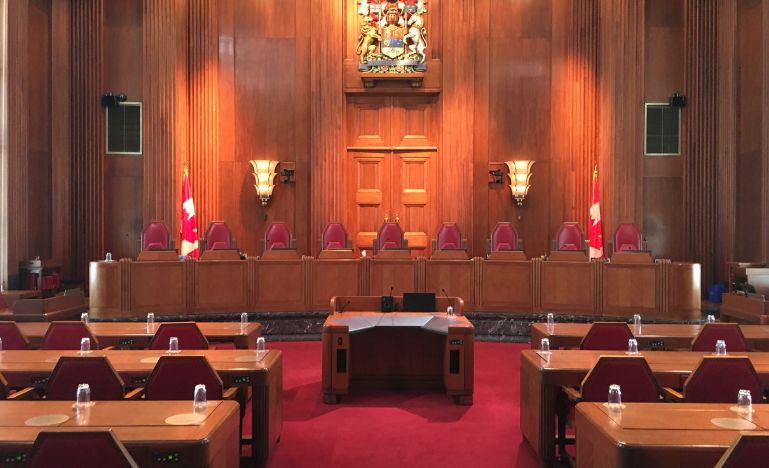Supreme Court clarifies ‘air of reality’ test in high-profile homicide case
New trials ordered in a matter that’s garnered international attention as the focus of a Netflix true crime documentary

The Supreme Court of Canada has upheld a decision to overturn the first-degree murder conviction of Jennifer Pan and ordered a new trial for her and the others alleged to have been involved in a murder-for-hire plot that left Pan’s mother dead and father critically injured.
The decision by a trial judge to exclude a defence theory from the jury instructions because it lacked an air of reality was at the heart of the Court’s 7-2 decision, which affirmed one released by the Ontario Court of Appeal in 2023.
It’s a case that has garnered international attention as the focus of a Netflix true crime documentary.
It began in 2010 when Pan, who had a troubled relationship with her parents, allegedly worked with a friend and his roommate to kill her father. That plan fell apart when the roommate stopped responding. Pan then claimed that she was depressed and was going to pay a friend of her boyfriend to kill her, but when her situation with her parents improved, she planned to pay him a cancellation fee instead. That evening, a home invasion was staged, and three armed intruders entered her home, took her parents to the basement and shot them both in the head and shoulders while Pan herself was tied up. Her mother was killed, but her father survived.
At trial, Pan and the three accomplices were convicted of first-degree murder for her mother’s death and the attempted murder of her father. The judge refused to consider a third scenario to instruct the jury, where the plan had only been to kill Pan’s father, which could have reduced the charge to second-degree murder or manslaughter, stating the scenario lacked an air of reality for those lesser and included charges.
The Court of Appeal set aside the first-degree murder conviction and ordered a new trial, finding the jury should have been able to consider the third scenario, as there was indeed an air of reality. The attempted murder conviction was upheld. Both the Crown and the accused appealed and cross-appealed.
At the Supreme Court, the majority agreed with the Court of Appeal, upholding its decision to order a new trial on the murder charge while maintaining the attempted murder conviction.
“After outlining the relevant principles, I conclude that the included offences had an air of reality in this case and that the jury should have been permitted to consider them,” Chief Justice Richard Wagner wrote for the majority.
He clarified that a trial judge’s determination about whether there is an air of reality is a question of law reviewable on the standard of correctness.
“Trial judges must come to the correct answer on the air of reality question and, if they do not, they have committed a reviewable legal error,” Wagner wrote.
He also said that the legal standard in the air of reality test does not change regardless of whether the Crown or defence is arguing if the test has been met.
Kyla Lee of Acumen Law in Vancouver, and past president of the CBA’s criminal justice section, says it’s good that the Court was explicit about the standard of review when applied in this context because there had been some confusion.
“I like the details in relation to better explaining the air of reality test and the judge’s function in doing a brief evidentiary examination before leaving with the jury or the trier-of-fact.”
She says that as a lawyer whose practice is focused on driving-related offences, including DUIs and driving prohibitions, she often deals with the air of reality concerns with affirmative defences, including when it comes to people having a reasonable excuse for not providing a breath sample.
“Those things are important affirmative defences, and for us to have this really good clarification about the gatekeeping function of the trial judge in allowing this defence to be raised through the air of reality test is going to make my job easier,” Lee says.
John Rosen, senior partner at Rosen & Company Barristers, worries about a case like this with multiple victims, where there’s an attempt to reconcile the lesser and included offences in the murder charge, along with the desire by the accused to re-try the attempted murder convictions as well.
“What would a jury do if they had to assess a degree of liability with the murder? How would they have attempted to assess the attempted murder,” he asks.
“It’s either all or nothing, and depending on how they word the indictment, it could have been an aggravated assault because there was no lesser offence left with the jury on the attempted murder charge.”
While he understands the defence’s complaint, Rosen says he wouldn’t have called it a palpable and overriding error.
Lee says that in jury trials, there is a psychological potential for jurors to try and find a “middle ground” as a basis to convict somebody, which the majority points out can lead to wrongful convictions.
“Even though there may be situations where there may be a wrongful acquittal, guarding against wrongful conviction is the most important thing,” she says.
“So there still needs to be a good threshold in place for where the air of reality for included offences is put before a jury because it does increase the danger of a potentially wrongful conviction.”
The cross-appeal raised separate issues, including a claim that the judge erred in permitting a presentation prepared by the Crown to enter the jury room and an accusation of jury bias, but the top court dismissed those concerns.
Lee says that materials prepared by the Crown can be an issue in some cases because there is already an imbalance of resources between the Crown and the defence.
“The last thing you want as a defence lawyer is for the Crown, with its infinite resources, not having a stringent test before an aid is permitted for the use of the jury as it risks upsetting an imbalance that is already in place in criminal trials,” she says.
The Court emphasized that safeguards include ensuring it’s reasonably necessary and a well-formed caution to ensure that the jury doesn’t rely on it as an alternative to examining the evidence.
“That’s a good compromise to make the work of jurors easier, in the sense of having them efficiently render verdicts while also protecting the rights of the accused and protecting against wrongful conviction,” Lee says.


